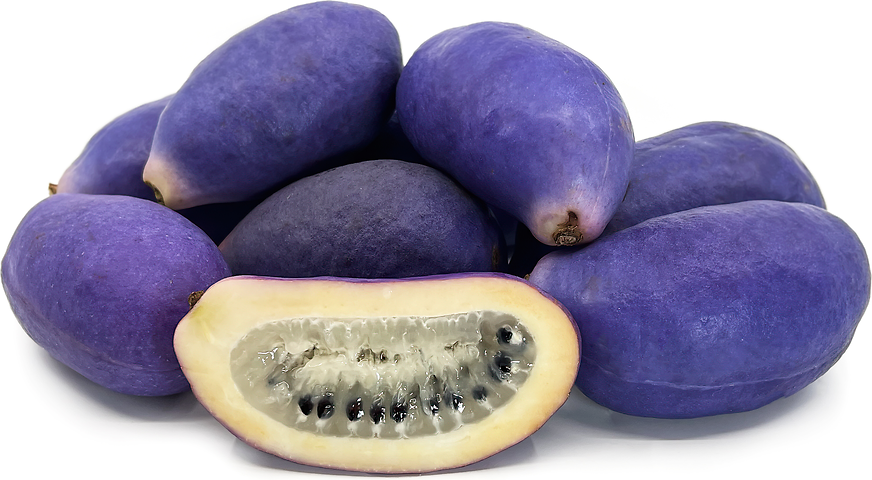


Purple Akebi Fruit
Estimated Inventory, lb : 0
Description/Taste
Purple Akebi is a cylindrical to oblong fruit, averaging 10-13 centimeters in length, that delicately hangs from trailing vines. There are multiple varieties of akebi fruit varying in size and appearance, but the skin is generally thick, spongy, and semi-firm with a soft give when squeezed. Depending on the variety, the fruit may also ripen from green to violet, grey, or purple-grey when mature. It is important to note that wild cultivars will split open when ripe, revealing their flesh, while cultivated varieties will remain unopened when mature. Underneath the skin, there is a translucent, gelatinous center that has many small and edible, black-brown seeds suspended throughout the flesh. Purple Akebi has a soft and crunchy consistency with a mild, sweet, and subtly bitter flavor. When consumed, the flesh melts into a semi-sweet liquid with notes of pear, coconut, and melon, while the seeds provide a mildly bitter taste and added texture.
Seasons/Availability
Purple Akebi is available for a limited season in the early fall.
Current Facts
Purple Akebi, botanically classified as Akebia quinata, is the fruit of a semi-evergreen, sprawling vine and is a member of the Lardizabalaceae family. The purple fruits are sometimes known as Akebia in rural villages and were initially found growing wild in the forests along the mountainsides in Japan. In the communities, ripe Purple Akebi was often a marker for the beginning of the fall season, and the plants were also known as the Chocolate Vine, which a reference to the flower’s candy-like scent when in bloom. Since ancient times, Purple Akebi was primarily considered a commercially unimportant fruit in Japanese markets due to its somewhat bland flavor and poor storage qualities. The obscure fruit remained mostly unknown for many decades until a cultivated variety was created to meet the increasing demand for exotic fruit. In the modern-day, the majority of Purple Akebi fruits sold in the market are the cultivated variety, and the fruits have become a specialty item sold to tourists, fruit enthusiasts, and as luxury gifts for friends and family.
Nutritional Value
Purple Akebi is a good source of vitamin C, which is an antioxidant that can protect the body against environmental aggressors and contains a combination of zinc and vitamin B6 to help strengthen the immune system. The fruits also provide calcium, potassium, and anti-inflammatory properties. In traditional Chinese medicine, the stems and fruits of the plant are used as a diuretic and are believed to help reduce dampness within the body.
Applications
Purple Akebi is best suited for both raw and cooked applications such as frying, sautéing, or grilling. The flesh can be scooped straight, out-of-hand with a spoon, and consumed, or it can be sliced open and slurped directly from the purple pod. Many Japanese believe that the flesh has a bland flavor, so lemon juice is commonly added to help balance the sweetness and add complexity. Purple Akebi can also be blended into drinks or smoothies, pickled in plum juice when young, or cooked into jellies and jams for added texture and flavor. When eating the flesh, it is important to note that the black-brown seeds are edible and can be swallowed, or they can be spit out and discarded depending on personal preference. Beyond the flesh, in regions of Tohoku, Japan, the pod is considered to be the prized portion of the fruit and is typically stuffed, stir-fried, or deep-fried. The pods can be fried into tempura, like other vegetables, or they can be steamed for a softer consistency, traditionally stuffed with ground meat, miso, and vegetables. The pods can also be mixed with salt and pickled cucumber to help decrease the bitter flavor and then cooked. In addition to the fruits, the young stems and flower buds of the plant can be blanched and tossed into salads or lightly stir-fried as a crisp side dish. The leaves are also used medicinally and can be steeped into teas. Purple Akebi pairs well with sesame oil, miso paste, shoyu or Japanese soy sauce, cooking sake, shiso leaf, noodles, rice, spicy sausage, onion, garlic, beans, spinach, and broccoli. The fresh fruits are highly perishable and should be used immediately when ripe for the best flavor.
Ethnic/Cultural Info
Purple Akebi was a large part of the Tohoku diet, a region in Northern Japan where the fruit was first discovered and still grows wild in the mountains in the modern-day. Before sugar was widely available, many townspeople regarded the Purple Akebi as the “Princess of the Mountain” for its unique semi-sweet flavor and aromatic flowers. The flesh of the fruit was a popular snack while villagers foraged for mushrooms in the forests, and the vines of the plant were woven together to make natural bags and baskets. The seeds were also used and were often pressed to create oils and herbal medicines that contained diuretic, antiseptic, and cold preventative properties. In addition to everyday uses, Purple Akebi was commonly offered on altars in the Yamagata prefecture during the Buddhist festival of Obon. The fruits were believed to be the vehicle that carried spirits of ancestors to and from this world during the festival.
Geography/History
Akebi fruit is native to the northern Tohoku region of Japan and is mainly cultivated in the Yamagata prefecture. The wild variety has been growing naturally since ancient times, and the cultivated variety has only been available commercially for the last few decades. Today Purple Akebi can be found in limited quantities at specialty markets and grocers in Japan, China, and Korea. The fruits are also grown on a very small-scale across Europe, New Zealand, and in the United States.
Recipe Ideas
Recipes that include Purple Akebi Fruit. One
| Kudamononavi |
|
I Want to Know how to Eat Akebi |
| Kyoto Foodie |
|
Japanese Fruit Akebi as Sauteed Vegetable (Miso Itame) |
| Eat the Weeds |
|
Akebi Pod Miso Itame |
















